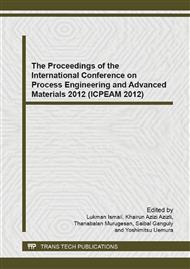[1]
S. Tabatabaei, A. Shukohfar, R. Aghababazadeh, and A. Mirhabibi, Experimental study of the synthesis and characterisation of silica nanoparticles via the sol-gel method, 2006, p.371.
DOI: 10.1088/1742-6596/26/1/090
Google Scholar
[2]
H. Zou, S. Wu, and J. Shen, Polymer/silica nanocomposites: preparation, characterization, properties, and applications, Chem . Rev. , vol. 108 pp.3893-3957, (2008).
DOI: 10.1021/cr068035q
Google Scholar
[3]
S. Prabakar and R. A. Assink, Hydrolysis and condensation kinetics of two component organically modified silica sols* 1, J. Non-Cryst. Solids, vol. 211 1997, pp.39-48, (1997).
DOI: 10.1016/s0022-3093(96)00634-5
Google Scholar
[4]
X. J. Zhang, S. Y. Zhao, C. X. Gao, and S. J. Wang, Amorphous sol–gel SiO2 film for protection of an orthorhombic phase alloy against high temperature oxidation, J. Sol-Gel Sci. Technol, vol. 49, pp.221-227, (2009).
DOI: 10.1007/s10971-008-1863-4
Google Scholar
[5]
K. S. McCain and J. M. Harris, Total Internal Reflection Fluorescence-Correlation Spectroscopy Study of Molecular Transport in Thin Sol- Gel Films, Anal. Chem, vol. 75, pp.3616-3624, (2003).
DOI: 10.1021/ac0207731
Google Scholar
[6]
W. Li, S. Seal, E. Megan, J. Ramsdell, K. Scammon, G. Lelong, L. Lachal, and K. A. Richardson, Physical and optical properties of sol-gel nano-silver doped silica film on glass substrate as a function of heat-treatment temperature, J. Appl Phys., vol. 93 2003, p.9553, (2003).
DOI: 10.1063/1.1571215
Google Scholar
[7]
J. Hyeon-Lee, G. Beaucage, and S. E. Pratsinis, Aero-Sol- Gel Synthesis of Nanostructured Silica Powders, Chem. Mater, vol. 9, pp.2400-2403, (1997).
DOI: 10.1021/cm9703482
Google Scholar
[8]
R. Kreiter, M. D. A. Rietkerk, H. L. Castricum, H. M. van Veen, J. E. ten Elshof, and J. F. Vente, Evaluation of hybrid silica sols for stable microporous membranes using high-throughput screening, in J. Sol-Gel Sci. Technol. vol. 2010, 2010, pp.1-8.
DOI: 10.1007/s10971-010-2208-7
Google Scholar
[9]
K. S. Abou-El-Sherbini, Modification of aminopropyl silica gel with some chelating agents and their effect on its stability against hydrolysis, J. Sol-Gel Sci. Technol., vol. 51 2009, pp.228-237, (2009).
DOI: 10.1007/s10971-009-1975-5
Google Scholar
[10]
T. Yang, H. Tian, and Y. Chen, Preparation of superhydrophobic silica films with honeycomb-like structure by emulsion method, J. Sol-Gel Sci. Technol, vol. 49, pp.243-246, (2009).
DOI: 10.1007/s10971-008-1855-4
Google Scholar
[11]
T. Hwang, H. Y. Lee, H. Kim, and G. T. Kim, Two layered silica protective film made by a spray-and-dip coating method on 304 stainless steel, J. Sol-Gel sci. Technol., vol. 2010, pp.1-6, (2010).
DOI: 10.1007/s10971-010-2234-5
Google Scholar
[12]
Y. J. H. Choi, U. Luo, T. J. M., Spontaneous formation of silver nanoparticles in aminosilica, Journal of sol-gel science and technology, vol. 51, pp.124-132, (2009).
DOI: 10.1007/s10971-009-1934-1
Google Scholar
[13]
H. K. Guleryuz, I. Filiàtre, C. Grande, T. Einarsrud, M. A., Deposition of silica thin films formed by sol–gel method, Journal of sol-gel science and technology, vol. 54, pp.249-257, (2010).
DOI: 10.1007/s10971-010-2190-0
Google Scholar
[14]
L. L. W. Hench, J. K., The sol-gel process, Chem. Rev., vol. 90 pp.33-72, (1990).
Google Scholar
[15]
P. I. Falcaro, P., X-rays to study, induce, and pattern structures in sol–gel materials, J. Sol-Gel Sci. Technol., vol. 2011, pp.1-9, (2011).
DOI: 10.1007/s10971-009-2127-7
Google Scholar
[16]
C. J. Brinker and G. W. Scherer, Sol-gel science: the physics and chemistry of sol-gel processing: Academic Pr, (1990).
Google Scholar
[17]
C. R. Silva and C. Airoldi, Acid and Base Catalysts in the Hybrid Silica Sol-Gel Process, J. Colloid Interface Sci., vol. 195 1997, pp.381-387, (1997).
DOI: 10.1006/jcis.1997.5159
Google Scholar
[18]
C. J. Brinker and G. W. Scherer, The physics and chemistry of sol-gel processing, Sol-gel science, vol. 141, pp.58-59, (1990).
Google Scholar
[19]
G. Buelna and Y. S. Lin, Sol-gel-derived mesoporous [gamma]-alumina granules, Microporous and mesoporous materials, vol. 30, pp.359-369, (1999).
DOI: 10.1016/s1387-1811(99)00065-7
Google Scholar
[20]
P. S. Nayak and B. K. Singh, Instrumental characterization of clay by XRF, XRD and FTIR, Bulletin of Materials Science, vol. 30, pp.235-238, (2007).
DOI: 10.1007/s12034-007-0042-5
Google Scholar
[21]
H. K. C. Timken and M. M. Habib, Highly homogeneous amorphous silica-alumina catalyst composition, US Patent App. 20, 060/079, 398, (2005).
Google Scholar


